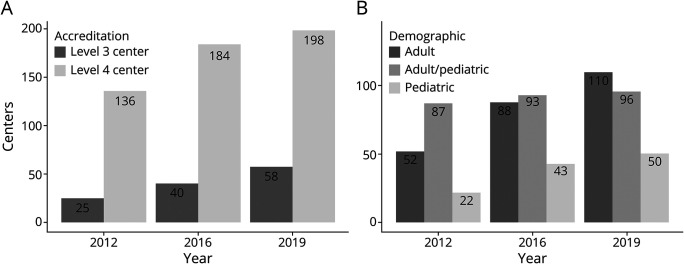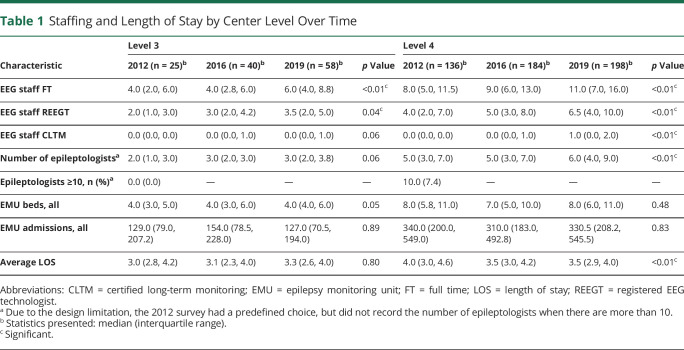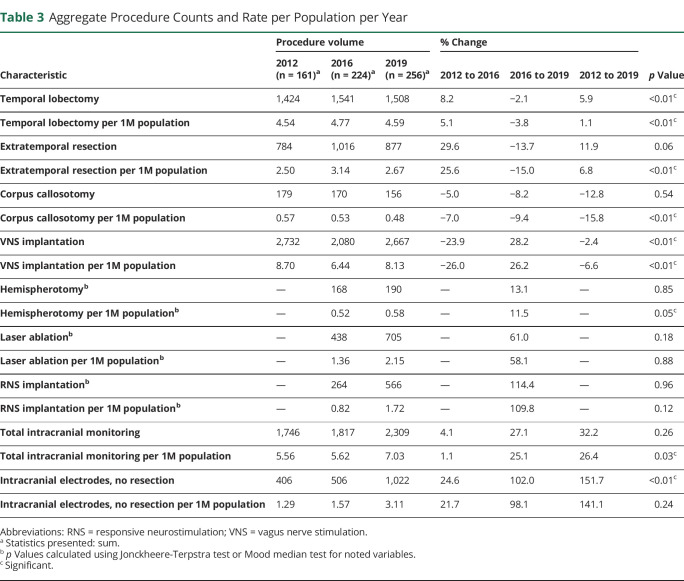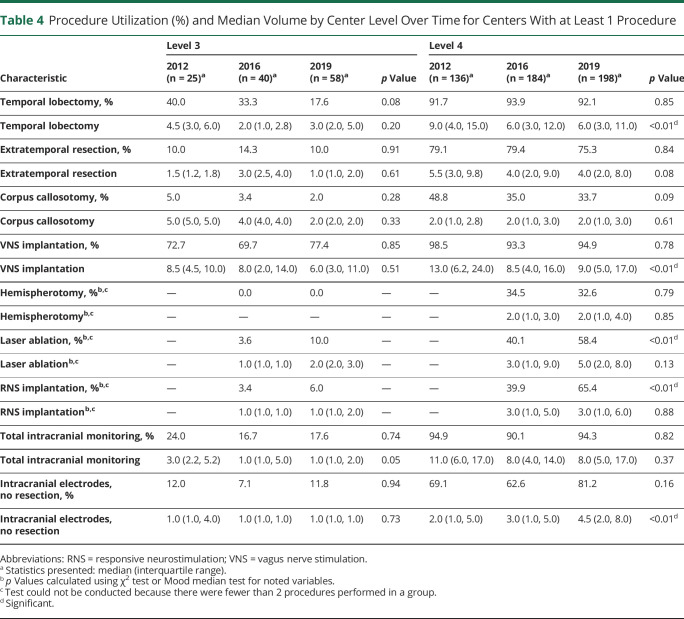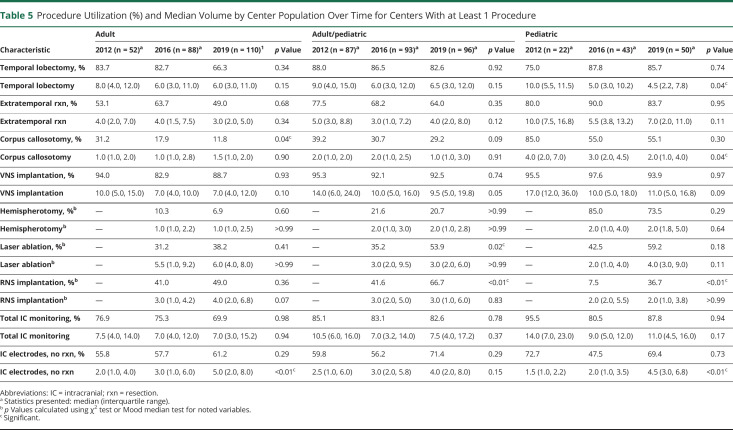Abstract
Background and Objectives
Patients with drug-resistant epilepsy (DRE) may benefit from specialized testing and treatments to better control seizures and improve quality of life. Most evaluations and procedures for DRE in the United States are performed at epilepsy centers accredited by the National Association of Epilepsy Centers (NAEC). On an annual basis, the NAEC collects data from accredited epilepsy centers on hospital-based epilepsy monitoring unit (EMU) size and admissions, diagnostic testing, surgeries, and other services. This article highlights trends in epilepsy center services from 2012 through 2019.
Methods
We analyzed data reported in 2012, 2016, and 2019 from all level 3 and level 4 NAEC accredited epilepsy centers. Data were described using frequency for categorical variables and median for continuous variables and were analyzed by center level and center population category. EMU beds, EMU admissions, epileptologists, and aggregate procedure volumes were also described using rates per population per year.
Results
During the period studied, the number of NAEC accredited centers increased from 161 to 256, with the largest increases in adult- and pediatric-only centers. Growth in EMU admissions (41%), EMU beds (26%), and epileptologists (109%) per population occurred. Access to specialized testing and services broadly expanded. The largest growth in procedure volumes occurred in laser interstitial thermal therapy (LiTT) (61%), responsive neurostimulation (RNS) implantations (114%), and intracranial monitoring without resection (152%) over the study period. Corpus callosotomies and vagus nerve stimulator (VNS) implantations decreased (−12.8% and −2.4%, respectively), while growth in temporal lobectomies (5.9%), extratemporal resections (11.9%), and hemispherectomies/otomies (13.1%) lagged center growth (59%), leading to a decrease in median volumes of these procedures per center.
Discussion
During the study period, the availability of specialty epilepsy care in the United States improved as the NAEC implemented its accreditation program. Surgical case complexity increased while aggregate surgical volume remained stable or declined across most procedure types, with a corresponding decline in cases per center. This article describes recent data trends and current state of resources and practice across NAEC member centers and identifies several future directions for driving systematic improvements in epilepsy care.
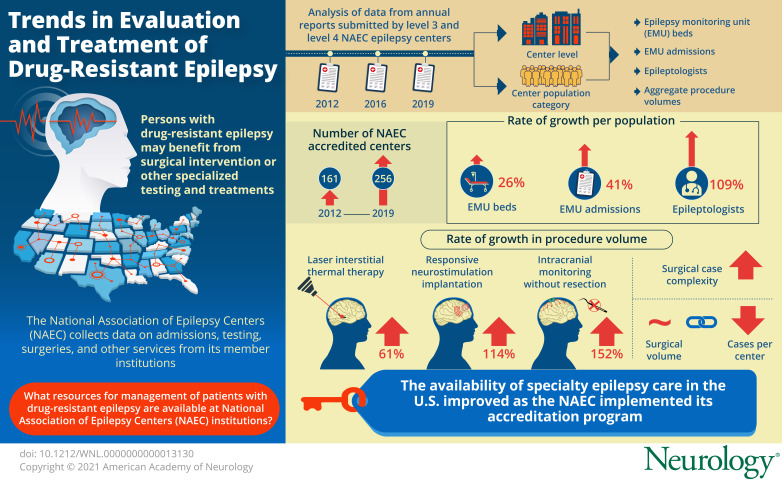
Epilepsy affects 1%–2% of the global population, with an estimated prevalence of 3.4 million persons in the United States.1 About 30% continue to have refractory seizures despite treatment with antiseizure medications (ASMs),2 leading to increased morbidity and mortality, decreased quality of life, and increased health care utilization.3,4 Persons with drug-resistant epilepsy (DRE) may benefit from surgical intervention, dietary therapy, or access to investigational trials.5,6 Therefore, the American Academy of Neurology (AAN) and other professional organizations recommend persons with DRE discuss or undergo evaluation at a comprehensive epilepsy center for consideration of epilepsy surgery evaluation and other specialized services.7-9 Epilepsy center practices are steered by national and international practice guidelines and quality measures establishing standards in care delivery and patient safety.8,10,11
Most evaluations and procedures in the United States for DRE are performed at National Association of Epilepsy Centers (NAEC) member institutions. The NAEC is a nonprofit association with a membership of more than 260 epilepsy centers. NAEC requires completion of an annual accreditation process by every member center to evaluate certain criteria of specialized epilepsy centers as outlined by NAEC.8 Centers are recognized as level 3 or level 4 centers based on center resources, with level 4 centers serving as regional or national referral sites with comprehensive diagnostic and surgical treatment capabilities.8 In general, level 3 epilepsy centers are facilities with EEG, neuroimaging, interdisciplinary epilepsy care, vagus nerve stimulator (VNS) insertion, and epilepsy surgeries not requiring invasive monitoring. Level 4 centers are distinguished by expertise with specialized neuroimaging, intracranial EEG, and more complex surgical techniques. Formal accreditation was implemented in 2015 based on expanded criteria.8 Member centers self-report data regarding services provided, procedure volumes, and staff numbers. Sample diagnostic and surgical reports are uploaded and reviewed. Credentials of listed personnel are verified by NAEC staff to meet required levels of certification.
Kaiboriboon and colleagues12 reviewed NAEC annual report data between 2003 and 2012 and reported growth in number of epilepsy centers, total surgeries, and total VNS insertions across NAEC centers. Since then, NAEC implemented its accreditation program and the number of centers accredited by NAEC greatly expanded. This article describes recent data trends and current state of resources and practice across NAEC member centers and identifies several future directions for driving systematic improvements in epilepsy care.
Methods
We analyzed data obtained from annual reports submitted for 2012, 2016, and 2019 from all level 3 and level 4 NAEC epilepsy centers (eAppendices 1–3, links.lww.com/WNL/B678). These years were selected to assess trends beginning from the last NAEC data publication to the most recently available data.12 All reported data were collected prior to the COVID-19 pandemic.
Statistical Methods
Data were analyzed using frequency (%) for categorical variables and median (interquartile range [IQR]) for continuous variables. Select variables per capita were described using rates based on US total population data collected from the US Census Bureau (data.census.gov/cedsci). Dependent variables were analyzed by center level (level 3 vs level 4) and by center population (adult only, adult/pediatric combined, or pediatric only). Procedure data in tables are presented 2 ways. First, the frequency (percentage) of centers that performed at least one procedure was displayed. Then, the median (IQR) of procedures performed among those centers that performed at least one of the procedures (excluding zeros) was calculated.
Minor changes in the way data were collected occurred during the study time frame. For example, in 2012, centers with >9 epileptologists were all marked as having ≥10 (censored). Thus, both the median for uncensored values and the frequency/percent of censored epileptologist values were reported. This also caused the rate of epileptologists per 1,000,000 population to appear artificially low that year.
If a variable was not collected in one of the years, for example, the 2012 annual report did not include data on center access to magnetoencephalography (MEG), neuropsychology testing, hemispherotomies, laser interstitial thermal therapy (LiTT), or responsive neurostimulation (RNS) implantation (approved by the Food and Drug Administration in 2013), these observations were not considered missing. However, rarely, data points were missing from individual center annual reports and the percent missing data per field was calculated. The intracranial monitoring total was the sum of reported temporal lobectomies with intracranial electrodes, extratemporal resections with intracranial electrodes, and intracranial electrodes with no resection. Missing values were ignored in these sums if one or more component procedure volumes was reported.
Due to the low number of years being compared, we applied nonparametric statistical tests to test for any increasing or decreasing trend across 3 years. For variables that are expressed as medians or rates per populace, the Jonckheere-Terpstra test13 was used. For variables that are expressed as binomial proportions, the Cochran-Armitage test was used.14,15 For variables collected only in 2016 and 2019, comparisons between years were conducted using the 2-sided Mood16 median test for medians and the χ2 test for proportions. Mood test is a nonparametric alternative to the t test for small sample size and non-normally distributed data. If only one procedure was performed in a combination of year and accreditation level/patient demographic, a statistical test could not be computed, and no p values were calculated. Due to the descriptive nature of the study, no multiple testing correction was applied. Two-sided p values less than 0.05 were considered statistically significant. All analyses were conducted using R 4.0 (R Core Team).
Standard Protocol Approvals, Registrations, and Patient Consents
The ethical standards committee at Nationwide Children's Hospital determined this study exempt from institutional review board approval.
Data Availability
Qualified researchers may request data using the NAEC policy governing the release of member center data (naec-epilepsy.org/wp-content/uploads/NAECBoardPoliciesforDataAccess.pdf).
Results
Reporting centers increased over time from 161 in 2012 to 256 in 2019. Annual report completion rate was 100% across all years. The range of data missingness for all variables was <10% (eTable 1, links.lww.com/WNL/B678).
Center Demographics and Services
NAEC member centers grew across all levels and populations during the study period (Figure 1). The largest increase occurred in adult- or pediatric-only centers, rather than those serving both children and adults. Summary findings for center personnel, facility size, and characteristics are detailed by center level (Table 1) and patient population (Table 2).
Figure 1. Number of National Association of Epilepsy Centers Member Centers Over Time.
(A) By Level. (B) Demographic.
Table 1.
Staffing and Length of Stay by Center Level Over Time
Table 2.
Staffing and Length of Stay by Center Population Over Time
Median center size (epilepsy monitoring unit [EMU] beds and admissions) did not change. However, aggregate access to epilepsy care per population did increase, with most of the increase driven by increased numbers of level 3 and pediatric centers. Per 1 million people, EMU admissions increased from 2012 to 2019 from 11.7 to 30.3 (+159%) in level 3 centers and 193 to 259 (+34%) in level 4 centers. By population served per 1 million people, EMU admissions changed from 37.6 to 75.4 (+100%) in adult centers, 129.2 to 121.3 (−6%) in combined centers, and 38.1 to 93.1 (+144%) in pediatric centers. Length of stay decreased in level 4 centers and those that served combined adult/pediatric populations.
Growth was positive in EMU beds per 1 million people (level 3: 0.3 to 0.9 [+200%]; level 4: 3.6 to 4.3 [+47%]; adult centers: 0.9 to 2.1 [+133%]; combined centers: 2.5 to 2.8 [+12%]; pediatric centers: 0.5 to 1.3 [+160%]). Number of epileptologists per 1 million people also increased from 2012 to 2019 (level 3: 0.2 to 0.5 [+150%]; level 4: 2.0 to 4.1 [+105%]; adult centers: 0.6 to 1.6 [+167%]; combined centers: 1.3 to 2.1 [+62%]; pediatric centers: 0.3 to 1.0 [+233%]).
Growth in median center staff EEG technologists occurred in adult and combined adult/pediatric centers (Table 2). Centers hired more registered EEG technologists (REEGTs) in adult and pediatric centers and certified long-term EEG technologists in combined and pediatric centers. Total certified EEG technologists accounted for more than half of technologists at centers.
Access to testing modalities and specialized services broadly expanded across both levels (eTable 2, links.lww.com/WNL/B678) and all populations (eTable 3). Greatest growth areas included alternative/complementary medicine (adult centers 1.9%–32.9%; combined centers 0%–51.1%; pediatric centers 0%–36%), ketogenic diet in level 3 and adult centers (level 3 28%–48.3%; adult centers 36.5%–54.5%), and genetic testing or counseling (level 3 64%–79.3%; level 4 72.8%–90.9%; pediatric centers 63.6%–100%). Access to MEG, which was only included in 2016 and 2019 survey data, was relatively stable (level 3 0%–8.6%; level 4 23.9%–19.2%; adult centers 11.4%–12.7%; combined centers 18.3%–12.5%; pediatric centers 39.5%–34%).
Center Procedures
Procedure data were analyzed across all years by aggregate volumes and population rates (Table 3) and by center level median volume and utilization rate by level (Table 4) and patient population (Table 5). Most surgeries were performed at level 4 centers (eFigure 1, links.lww.com/WNL/B678).
Table 3.
Aggregate Procedure Counts and Rate per Population per Year
Table 4.
Procedure Utilization (%) and Median Volume by Center Level Over Time for Centers With at Least 1 Procedure
Table 5.
Procedure Utilization (%) and Median Volume by Center Population Over Time for Centers With at Least 1 Procedure
Over the study period, the total volume of temporal lobectomies (5.9%), extratemporal resections (11.9%), and hemispherectomies/otomies (13.1%) increased slower than center growth (59%). Corpus callosotomies (−12.8%) and VNS implantations (−2.4%) decreased during the study timeframe. In contrast, growth in laser ablations (61%), RNS implantations (114%), and intracranial monitoring without resection (152%) outpaced overall center growth.
Median volumes of some procedure types changed over time between center levels. Median number of temporal lobectomies decreased in level 4 centers from 9 to 6 (p = 0.01), but changes in extratemporal resections in level 4 centers did not reach significance (5.5–4; p = 0.08). Level 4 centers performed fewer VNS implantations (13–9; p ≤ 0.01). Level 4 centers performed more intracranial monitoring without resection (2–4.5; p ≤ 0.01), while level 3 centers performed less (3–1; p = 0.05).
Procedures across target populations changed as well. Corpus callosotomies decreased in adult centers from 15 to 12 (p = 0.04). Pediatric centers had a decrease in temporal lobectomies from 10 to 4.5 (p = 0.04) and corpus callosotomies from 4 to 2 (p = 0.04). Median intracranial monitoring without resection procedures increased in adult centers from 2 to 5 (p ≤ 0.01) and pediatric centers from 1.5 to 4.5 (p ≤ 0.01).
Procedure utilization changed over time. LiTT and RNS were most often utilized by level 4 centers and increased substantially from 40.1% to 58.4% (p ≤ 0.01) and 39.9%–65.4% (p ≤ 0.01), respectively. LiTT utilization also increased in combined centers from 35.2% to 53.9% (p = 0.02). There were no significant changes in median LiTT procedures, though they trended up in pediatric centers from 2 to 4 (p = 0.11). RNS utilization increased in combined centers from 41.6% to 66.7% (p ≤ 0.01) and pediatric centers from 7.5% to 36.7% (p ≤ 0.01) with no change in procedure medians across categories.
Discussion
Over the study period, access to specialty epilepsy care in the United States improved as the NAEC implemented accreditation criteria and expanded from 161 to 256 centers. Member centers increased available epilepsy services and hired more epileptologists and EEG technologists. Surgical case complexity increased while aggregate surgical volume remained stable or declined slightly across most procedure types, with a corresponding decline in cases per center. This study highlights several changing trends in epilepsy management in the United States, identifies important data gaps, and underscores future opportunities to study and improve quality care.
Implementation of accreditation criteria emphasizing a broad range of services delivered by expert medical personnel increased center accountability even as center availability also increased. Center growth was greatest among adult- or pediatric-focused centers rather than combined adult/pediatric centers. This is likely due in part to a change in NAEC requirements for center accreditation resulting in hospitals with combined adult/pediatric centers applying for separate accreditation.
Aggregate increases in EMU beds, EEG staff, and epileptologists followed similar trends. Centers hired more epileptologists and EEG technologists, while median EMU beds and admissions per center were stable. Growth in median number of epileptologists per center parallels an increase in case complexity,17 increasing ICU continuous EEG volume,18 and outpatient volume. Growth in EEG technologists reflects similar trends. Technologists are increasingly called upon to monitor and screen continuous video-EEG studies.19 Most are obtaining REEGT credentials after meeting professional competencies, a qualifying examination, and continuing education requirements. However, few hold Certification in Long-Term Monitoring credentials, which may present an opportunity to further improve seizure detection and patient care.20
Availability of supplemental services across NAEC-accredited centers increased during the study period. Alternative or complementary medicine is now available at nearly half of centers, where previous availability was sparse. Ketogenic diet availability has grown in level 3 centers and adult centers. Genetic testing and counseling have been increasingly utilized for epilepsy diagnosis and management across level 3 and level 4 centers. Access to advanced diagnostic and therapeutic options increased over the study period even as more epilepsy centers achieved NAEC accreditation.
Despite an increase in access to epilepsy centers, aggregate surgical volumes did not uniformly increase across all procedures. Temporal lobectomies, extratemporal resections, and hemispherectomies/otomies did not keep pace with center growth, and corpus callosotomy and VNS implantation volumes decreased over the study period. In contrast, LiTT, RNS implantation, and intracranial monitoring without resection grew substantially in aggregate, although median center volumes did not. The sole procedure type with increasing median volumes across centers was intracranial monitoring without resection.
The trends in surgical procedures reflect a shift in epilepsy surgery toward greater surgical case complexity and use of newer technology. Stereo EEG is increasingly utilized across the United States and may carry a better safety and tolerability profile compared to subdural grids,21 which likely lowers the threshold for performing intracranial monitoring.22 Increasing use of LiTT may have displaced some temporal lobectomies, although the increase of LiTT cases far exceeded the decline in temporal lobectomies from 2016 to 2019.12,23-25 However, despite introduction of new techniques and technologies, the overall rate of epilepsy surgery has not kept pace with the growth in NAEC centers.26,27
The current NAEC accreditation process emphasizes structural and process measures of health care quality. Accreditation criteria for all NAEC members include staffing centers with well-trained personnel, establishing safety and quality protocols, and providing a breadth of key services. Board-certified epileptologists and surgeons with specific epilepsy experience are accreditation criteria for level 4 centers and level 3 centers that perform surgery.
Assigning a process measure of minimum surgical volume for epilepsy surgery centers is an ongoing topic of interest. Several evidence-based recommendations from International League Against Epilepsy and other working groups have proposed minimum procedure volumes for epilepsy centers.7,28,29 These recommendations are, in part, based on a higher complication rate in disconnection or resection surgeries at centers with fewer than 15 such procedures per year.23,30 However, NAEC does not require a minimal surgical volume for epilepsy centers, as reliance on volume measures alone can also result in unintended consequences, such as centers performing unnecessary surgery or certain types of surgery simply to attain accreditation status.
Patient outcome data across epilepsy centers are urgently needed to develop outcome measures and better incentivize quality care. Data across epilepsy center networks could be collected as part of the NAEC accreditation process, with the goal of progressively expanding the set of data collected and increasing the standard of care. Indeed, NAEC is helping fund a practice-based learning health network focused on epilepsy care that may provide data and infrastructure to improve outcomes.31 Addressing these data gaps will better enable the study of seizure-related outcomes and quality of life across large care delivery networks.
The findings are limited primarily by how data were acquired through the NAEC accreditation annual reports. Data acquisition methods changed during the study period and rely primarily on self-reporting of administrative data. The response rate was 100% with a very low range of missingness since the annual data are required for NAEC accreditation. Our data are in line with previous studies while providing novel data regarding center characteristics. Although NAEC member centers do not provide the entirety of epilepsy care in the United States, they likely represent most of the specialized evaluation and procedures for those with DRE. For instance, the Veterans Affairs health care system is a large provider within the United States, yet performed 5 resections for epilepsy in 2019 and implanted 4 neurostimulators.32 Therefore, our analysis likely reflects accurate data regarding major trends and the current state in epilepsy care in the United States.
Specialty epilepsy care in the United States has significantly changed over the study period. Additional studies are required to better understand the influence of epilepsy center characteristics on testing, treatment, and outcomes. Epilepsy centers are key to standardizing access and delivery of epilepsy care across health care networks.
Acknowledgment
The authors thank the former NAEC board members and the medical directors of NAEC-accredited epilepsy centers that submit data annually to NAEC and who supported the strengthening of NAEC's accreditation program to improve the quality of epilepsy care in the United States.
Glossary
- AAN
American Academy of Neurology
- ASM
antiseizure medication
- CLTE
certified long-term EEG technologist
- DRE
drug-resistant epilepsy
- EMU
epilepsy monitoring unit
- IQR
interquartile range
- LiTT
laser interstitial thermal therapy
- MEG
magnetoencephalography
- NAEC
National Association of Epilepsy Centers
- REEGT
registered EEG technologist
- RNS
responsive neurostimulation
- VNS
vagus nerve stimulator
Appendix. Authors

Footnotes
Study Funding
This study was supported by Award 45141-0001-0321 from Nationwide Children's Hospital and Award 810712-1221-00 from the National Association of Epilepsy Centers.
Disclosure
The authors report no disclosures relevant to the manuscript. Go to Neurology.org/N for full disclosures.
References
- 1.Zack MM, Kobau R. National and state estimates of the numbers of adults and children with active epilepsy: United States, 2015. MMWR Morb Mortal Wkly Rep. 2017;66(31):821-825. [DOI] [PMC free article] [PubMed] [Google Scholar]
- 2.Kwan P, Brodie MJ. Early identification of refractory epilepsy. N Engl J Med. 2000;342(5):314-319. [DOI] [PubMed] [Google Scholar]
- 3.Ostendorf AP, Gedela S. Effect of epilepsy on families, communities, and society. Semin Pediatr Neurol. 2017;24(4):340-347. [DOI] [PubMed] [Google Scholar]
- 4.Wilner AN, Sharma BK, Thompson A, Soucy A, Krueger A. Diagnoses, procedures, drug utilization, comorbidities, and cost of health care for people with epilepsy in 2012. Epilepsy Behav. 2014;41:83-90. [DOI] [PubMed] [Google Scholar]
- 5.Dwivedi R, Ramanujam B, Chandra PS, et al. Surgery for drug-resistant epilepsy in children. N Engl J Med. 2017;377(17):1639-1647. [DOI] [PubMed] [Google Scholar]
- 6.Wiebe S, Blume WT, Girvin JP, Eliasziw M. Effectiveness and efficiency of surgery for temporal lobe epilepsy study group: a randomized, controlled trial of surgery for temporal-lobe epilepsy. N Engl J Med. 2001;345:311-318. [DOI] [PubMed] [Google Scholar]
- 7.Rosenow F, Bast T, Czech T, et al. Revised version of quality guidelines for presurgical epilepsy evaluation and surgical epilepsy therapy issued by the Austrian, German, and Swiss working group on presurgical epilepsy diagnosis and operative epilepsy treatment. Epilepsia. 2016;57(8):1215-1220. [DOI] [PubMed] [Google Scholar]
- 8.Labiner DM, Bagic AI, Herman ST, et al. . Essential services, personnel, and facilities in specialized epilepsy centers: revised 2010 guidelines: guidelines for specialized epilepsy centers. Epilepsia. 2010;51:2322-2333. [DOI] [PubMed] [Google Scholar]
- 9.Patel AD, Baca C, Franklin G, et al. Quality improvement in neurology: epilepsy quality measurement set 2017 update. Neurology. 2018;91(18):829-836. [DOI] [PubMed] [Google Scholar]
- 10.National Clinical Guideline Centre (UK). The Epilepsies: The Diagnosis and Management of the Epilepsies in Adults and Children in Primary and Secondary Care: Pharmacological Update of Clinical Guideline 20 [online]. ncbi.nlm.nih.gov/books/NBK247130/. Royal College of Physicians; 2012. Accessed February 23, 2021. [PubMed] [Google Scholar]
- 11.Fountain NB, Van Ness PC, Swain-Eng R, Tonn S, Bever CT. American Academy of Neurology Epilepsy Measure Development Panel and the American Medical Association-Convened Physician Consortium for Performance Improvement Independent Measure Development Process. Quality improvement in neurology: AAN epilepsy quality measures: report of the quality measurement and reporting subcommittee of the American Academy of neurology. Neurology. 2011;76(1):94-99. [DOI] [PubMed] [Google Scholar]
- 12.Kaiboriboon K, Malkhachroum AM, Zrik A, et al. Epilepsy surgery in the United States: analysis of data from the National Association of Epilepsy Centers. Epilepsy Res. 2015;116:105-109. [DOI] [PubMed] [Google Scholar]
- 13.Jonckheere AR. A distribution-free k-sample test against ordered alternatives. Biometrika. 1954;41:133. [Google Scholar]
- 14.Cochran WG. Some methods for strengthening the common χ 2 tests. Biometrics. 1954;10:417. [Google Scholar]
- 15.Armitage P. Tests for linear trends in proportions and frequencies. Biometrics. 1955;11:375. [Google Scholar]
- 16.Mood AM. On the asymptotic efficiency of certain nonparametric two-sample tests. Ann Math Statist. 1954;25:514-522. [Google Scholar]
- 17.Cukiert A, Rydenhag B, Harkness W, Cross JH, Gaillard WD; task force for pediatric epilepsy surgery for the ILAE commissions of pediatrics and surgical therapies. Technical aspects of pediatric epilepsy surgery: report of a multicenter, multinational web-based survey by the ILAE task force on pediatric epilepsy surgery. Epilepsia. 2016;57:194-200. [DOI] [PubMed] [Google Scholar]
- 18.Ney JP, van der Goes DN, Nuwer MR, Nelson L, Eccher MA. Continuous and routine EEG in intensive care: utilization and outcomes, United States 2005-2009. Neurology. 2013;81(23):2002-2008. [DOI] [PMC free article] [PubMed] [Google Scholar]
- 19.Gavvala J, Abend N, LaRoche S, et al. Continuous EEG monitoring: a survey of neurophysiologists and neurointensivists. Epilepsia. 2014;55(11):1864-1871. [DOI] [PubMed] [Google Scholar]
- 20.Ahrens S, Twanow JD, Vidaurre J, Gedela S, Moore-Clingenpeel M, Ostendorf AP. Electroencephalography technologist inter-rater agreement and interpretation of pediatric critical care electroencephalography. Pediatr Neurol. 2021;115:66-71. [DOI] [PMC free article] [PubMed] [Google Scholar]
- 21.Willems LM, Reif PS, Spyrantis A, et al. Invasive EEG-electrodes in presurgical evaluation of epilepsies: systematic analysis of implantation-, video-EEG-monitoring- and explantation-related complications, and review of literature. Epilepsy Behav. 2019;91:30-37. [DOI] [PubMed] [Google Scholar]
- 22.Gavvala J, Zafar M, Sinha SR, Kalamangalam G, Schuele S. Stereotactic EEG practices: a survey of United States tertiary referral epilepsy centers. J Clin Neurophysiol. Epub 2020 Nov 10. [DOI] [PubMed]
- 23.Kwon CS, Blank L, Mu L, Jetté N. Trends in lobectomy/amygdalohippocampectomy over time and the impact of hospital surgical volume on hospitalization outcomes: a population-based study. Epilepsia. 2020;61(10):2173-2182. [DOI] [PubMed] [Google Scholar]
- 24.Barba C, Specchio N, Guerrini R, et al. Increasing volume and complexity of pediatric epilepsy surgery with stable seizure outcome between 2008 and 2014: a nationwide multicenter study. Epilepsy Behav. 2017;75:151-157. [DOI] [PubMed] [Google Scholar]
- 25.Englot DJ, Ouyang D, Garcia PA, Barbaro NM, Chang EF. Epilepsy surgery trends in the United States, 1990-2008. Neurology. 2012;78(16):1200-1206. [DOI] [PMC free article] [PubMed] [Google Scholar]
- 26.Pestana Knight EM, Schiltz NK, Bakaki PM, Koroukian SM, Lhatoo SD, Kaiboriboon K. Increasing utilization of pediatric epilepsy surgery in the United States between 1997 and 2009. Epilepsia. 2015;56:375-381. [DOI] [PMC free article] [PubMed] [Google Scholar]
- 27.Cloppenborg T, May TW, Blümcke I, et al. Trends in epilepsy surgery: stable surgical numbers despite increasing presurgical volumes. J Neurol Neurosurg Psychiatry. 2016;87(12):1322-1329. [DOI] [PubMed] [Google Scholar]
- 28.Gaillard WD, Jette N, Arnold ST, et al. Establishing criteria for pediatric epilepsy surgery center levels of care: report from the ILAE Pediatric Epilepsy Surgery Task Force. Epilepsia. 2020;61(12):2629-2642. [DOI] [PubMed] [Google Scholar]
- 29.Binnie CD, Polkey CE; International League Against Epilepsy. Commission on neurosurgery of the international league against epilepsy (ILAE) 1993-1997: recommended standards. Epilepsia. 2000;41(10):1346-1349. [DOI] [PubMed] [Google Scholar]
- 30.Englot DJ, Ouyang D, Wang DD, Rolston JD, Garcia PA, Chang EF. Relationship between hospital surgical volume, lobectomy rates, and adverse perioperative events at US epilepsy centers. J Neurosurg. 2013;118(1):169-174. [DOI] [PubMed] [Google Scholar]
- 31.Donahue MA, Herman ST, Dass D, et al. Establishing a learning healthcare system to improve health outcomes for people with epilepsy. Epilepsy Behav. 2021;117:107805. [DOI] [PubMed] [Google Scholar]
- 32.Kelly P. Epilepsy Centers of Excellence. Annual Report Fiscal Year 2019 [online]. epilepsy.va.gov/docs/FY19AnnualReport-VHAEpilepsyCentersofExcellence.pdf. US Department of Veterans Affairs; 2019. Accessed February 18, 2021. [Google Scholar]
Associated Data
This section collects any data citations, data availability statements, or supplementary materials included in this article.
Data Availability Statement
Qualified researchers may request data using the NAEC policy governing the release of member center data (naec-epilepsy.org/wp-content/uploads/NAECBoardPoliciesforDataAccess.pdf).



